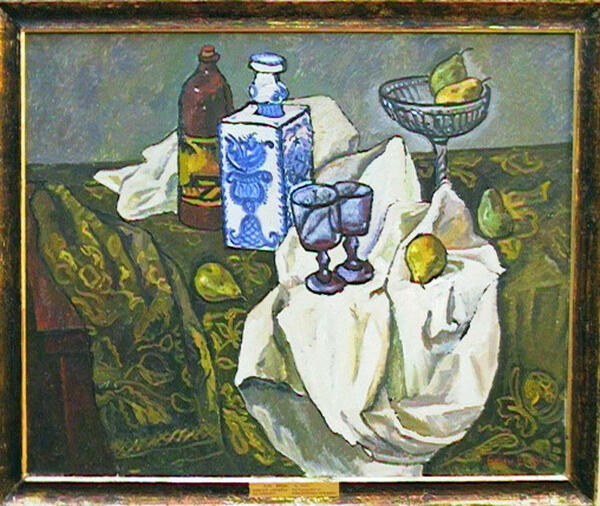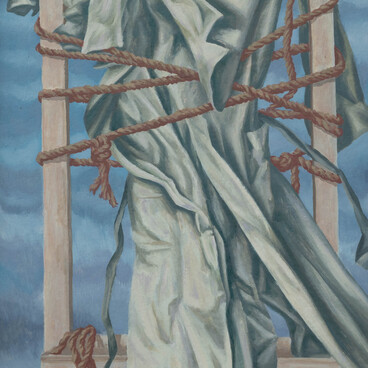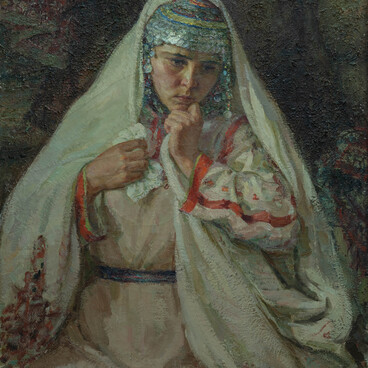Yevgeny Mikhailovich Yesin was born on September 9, 1951, in the city of Gorky (presently Nizhny Novgorod). He graduated from the Art and Graphics department of the Chuvash State Pedagogical University named after Ivan Yakovlev. He worked as a teacher of drawing and technical drawing at the Alatyr secondary school, he was also employed as a teacher at children’s art school No. 2 in Cheboksary.
The artist’s works include “First Foliage”, “Thaw”, “Spring Breeze”, “Late Evening”, “Still Life in Red”, “Still Life with an Anniversary Shtof”, the triptych “Old Things”, “Grandmother’s Samovar”, “Spring is Coming”, “It Is March Again”, “Paradise Apples”, “Self-Portrait”, “The Bay”, “Awakening”, “Early April”, “Still Life with Lilies” and others.
Yevgeny Yesin could create a succinct, multi-layered image with complex semantic overtones. The artist’s manner of painting is distinguished by the remarkable freshness, the color structure of the paintings and the distinctive brushstrokes. In general, the painter’s works demonstrate the traditional brushwork.
Among Yevgeny Yesin’s still lifes are some with traditional images of the genre such as “breakfasts” and “desserts”, but others include special, “Yesin’s” objects — all kinds of glass vessels that have a bizarre shape and unusual color — as well as outdated household items that have long gone out of use.
Among his lyrical still lifes, there are also social works. In them, objects often take on a symbolic meaning. Yesin developed his own style and manner of painting. His style is characterized by black-contoured objects and a general decorative effect.
Compositions are built either on the contrasts of local colors, or the finest nuances of yellow, green, blue, pink, and red. Objects in Yesin’s still lifes seem to come to life right before the viewer’s eyes, and their form begins to change, reaching a cubist decomposition of its original components in some of the works.
Still life is a genre where “nature morte” (dead nature) reigns: despite the absence of people in the painting, everything else betrays human presence. This way, the objects in Yevgeny Yesin’s still lifes lift the veil of the life of the people who came into contact with them.
The artist’s works include “First Foliage”, “Thaw”, “Spring Breeze”, “Late Evening”, “Still Life in Red”, “Still Life with an Anniversary Shtof”, the triptych “Old Things”, “Grandmother’s Samovar”, “Spring is Coming”, “It Is March Again”, “Paradise Apples”, “Self-Portrait”, “The Bay”, “Awakening”, “Early April”, “Still Life with Lilies” and others.
Yevgeny Yesin could create a succinct, multi-layered image with complex semantic overtones. The artist’s manner of painting is distinguished by the remarkable freshness, the color structure of the paintings and the distinctive brushstrokes. In general, the painter’s works demonstrate the traditional brushwork.
Among Yevgeny Yesin’s still lifes are some with traditional images of the genre such as “breakfasts” and “desserts”, but others include special, “Yesin’s” objects — all kinds of glass vessels that have a bizarre shape and unusual color — as well as outdated household items that have long gone out of use.
Among his lyrical still lifes, there are also social works. In them, objects often take on a symbolic meaning. Yesin developed his own style and manner of painting. His style is characterized by black-contoured objects and a general decorative effect.
Compositions are built either on the contrasts of local colors, or the finest nuances of yellow, green, blue, pink, and red. Objects in Yesin’s still lifes seem to come to life right before the viewer’s eyes, and their form begins to change, reaching a cubist decomposition of its original components in some of the works.
Still life is a genre where “nature morte” (dead nature) reigns: despite the absence of people in the painting, everything else betrays human presence. This way, the objects in Yevgeny Yesin’s still lifes lift the veil of the life of the people who came into contact with them.



